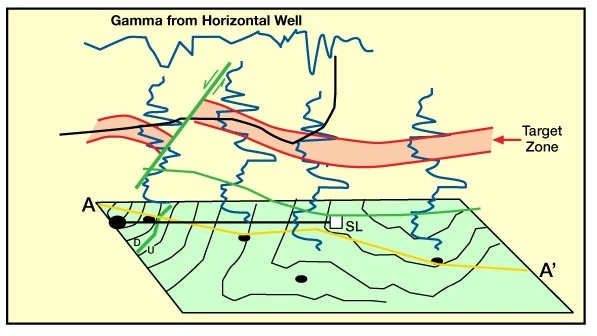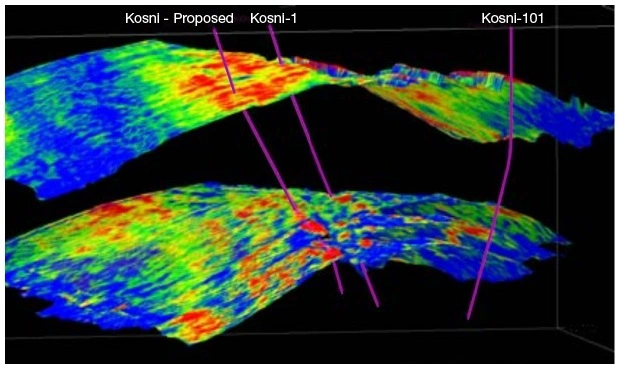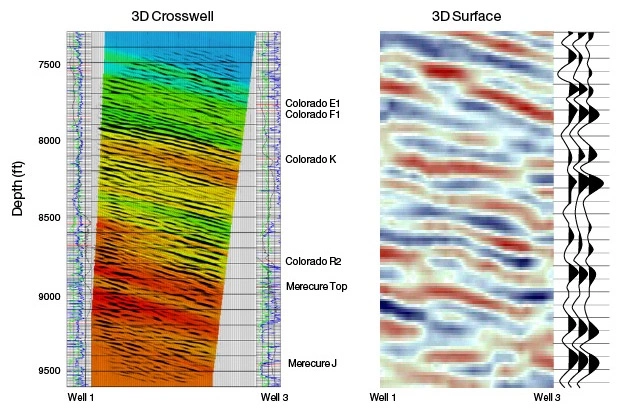Assignment Seismic Stratigraphy
1. You are reviewing 2D seismic lines from existing production in the huge Brent field in the northern portion of the North Sea. Based on the character of the structure and the reflections shown where the two wells are located in Figure 1, what kind of play is the Brent field? Document your reasoning for this interpretation.

Solution
The structure has a large unconformity with the surface at about the middle of the section. Beneath the unconformity, the beds dip to the lower left. There are several large faults just below the unconformity to the right of the right well. The trap would be bound by the top of the unconformity and the fault. Based on the interpretation, this suggests that this is a combination unconformity and fault play.
2. You are reviewing 2D seismic lines in a new play area away from existing production in West Texas, USA. In Figure 2, the structure at 1500 ms, just left of center in the section, is very noticeable. Based on the character of the structure and the reflections, what kind of play do you interpret this to be and why?

Solution
The structure has few reflectors within it. Based on the location of the structure in the section, it does not appear to be a basement structure, shale reflectors under a fault, or a zone of intense deformation. There also are no plugs, intrusives or evidence of sill branches. There is no evidence of a salt structure. Based on ruling out the above types of structures that typically have an absence of or few reflectors, the remaining interpretation would suggest this is a reef structure play.
Assessment Seismic Stratigraphy
1. Seismic stratigraphy is based on the fact that seismic stratigraphic units are linked to __________ .
2. In the situation of sediments being deformed into an anticline by vertical uplift, the crest is likely to exhibit which of the following in extreme cases? (Select all that apply.)
A .Sediment starvation
B .Extensional faulting
C .Possibly some collapse
D .Crestal thickening
3. Which of the following are geologic features where the absence of reflectors may be a valuable diagnostic for this type of structure? (Select all that apply.)
A .Stratigraphic pinchouts
B .Zones of intense tectonic deformation
C .Reefs
D .Salt domes
4. What are stratal surfaces?
A .Surfaces of submerged reefs
B .The surface of the Earth during some point in time
C .Reflection surfaces produced by fluid contacts
D .Erosional surfaces which imply lack of a chronostratigraphic interval
5. The limits of a seismic sequence are defined by _________ .
6. On a seismic section, unconformities which involve ________ relationship between good reflections are easy to see.
7. The technique of time interval mapping is valuable for identifying which type of targets? (Select all that apply.)
A .Growth faults
B .Erosional channels
C .Sand bars
D .Transform faults
E .Reefs
8. What are types of reflections that intersect time lines and are not related to geology? (Select all that apply.)
A .Grabens
B .Multiples
C .Diffractions
D .Faults
9. Why are unconformities so important to the interpreter? (Select all that apply.)
A .They confirm fault locations.
B .They are sequence boundaries.
C .They define the limits of genetically related sediments.
D .They are all simple to identify.
Recommended for You
Interpretation with Seismic Attributes
Seismic Interpretation Methods
 Petro Shine The Place for Oil and Gas Professionals.
Petro Shine The Place for Oil and Gas Professionals.



